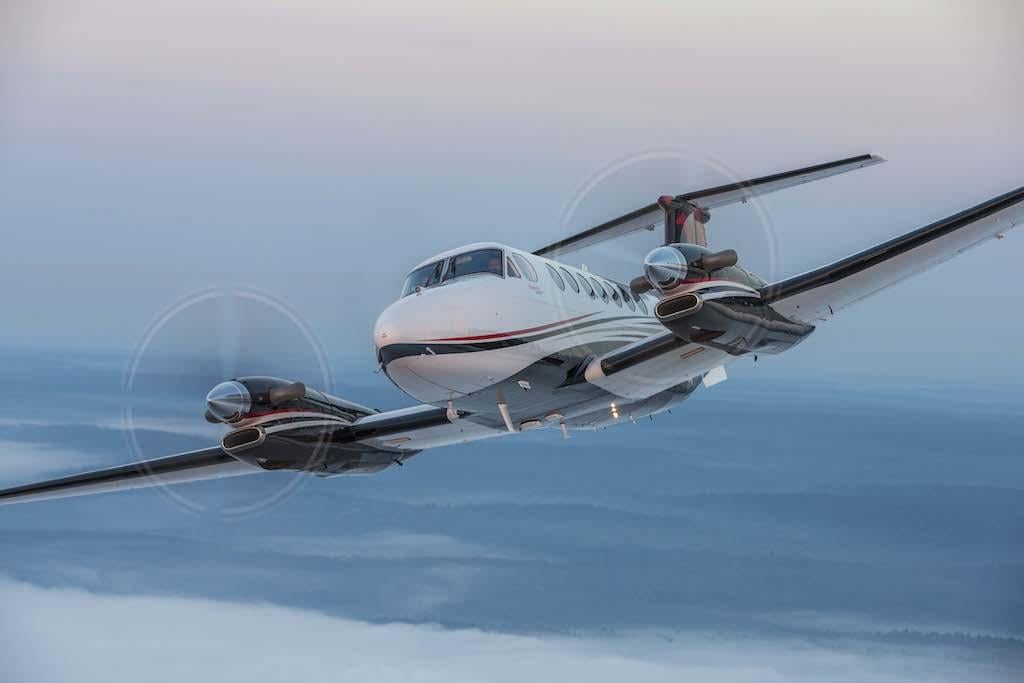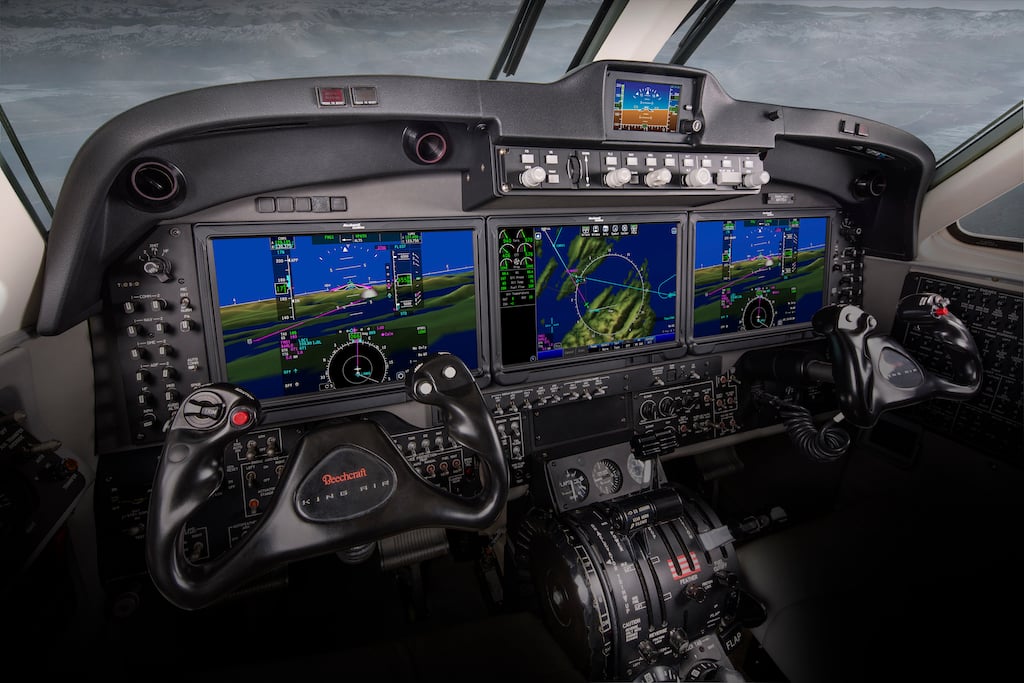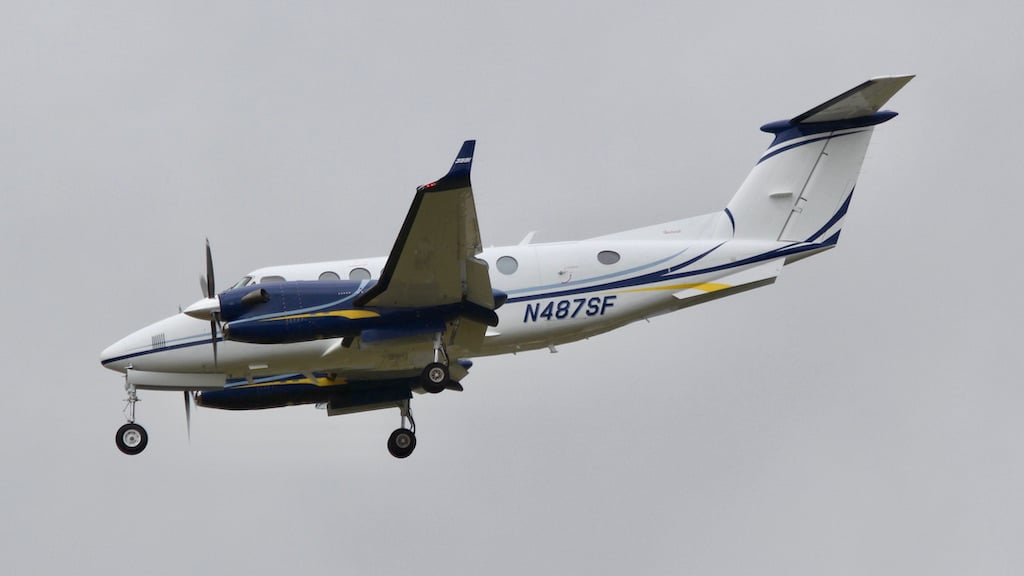
Operators and pilots eyeing the Beechcraft King Air 350 twin turboprop can be assured of a rugged and versatile performer that has been perfected over decades, say pre-owned aircraft sales executives.
Originally prefaced by the word “Super,” the King Air 350 was introduced in 1990 as a growth version of the King Air 300 with winglets and two additional cabin windows on each side. The 1990 factory-new list price of a King Air 350 was $3.75 million, according to the Aircraft Bluebook. In 2020, the King Air 350i listed at $7.8 million.
Aviation Week’s Fleet Discovery database in March counted 614 King Air 350s in service, 71 350ER (extended range) models and one 350HW (heavy weight) increased gross weight aircraft. There were 529 King Air 350i/350iER and 350C cargo variants. U.S. charter company Wheels Up has a fleet of 72 King Air 350is.
Textron Aviation’s pre-owned department reported 12 King Air 350s and nine King Air 350is for sale, representing 1.8% and 1.9% of the fleet, respectively.
Similarly, Jim Riner, managing partner of Englewood, Colorado-based Wetzel Aviation, reported 25 King Air 350/350is listed for sale in early March. Asking prices ranged from more than $2 million for earlier models to more than $7 million for later model year, pre-owned 350is. The 350/350is compete for sales with the King Air B200/250, Cessna Citation CJ3/CJ4 light jets and occasionally the Pilatus PC-12 single-engine turboprop, Riner said.
Wetzel Aviation, an International Aircraft Dealers Association-accredited aircraft brokerage, has been involved with the King Air 350 since deliveries started in the early 1990s.
“Pilots appreciate having a robust aircraft with predictable flight characteristics and a solid range profile that can operate in extreme conditions worldwide, if needed,” Riner said of the type. “Operators value the aircraft reliability, a global service network and a healthy number of companies that have made significant investment in bringing to market additional performance and equipment enhancements that have the effect of futureproofing the aircraft for years to come, preserving asset value.”
Pilots and operators value the type for its "reliability and high useful load," says Textron Aviation. "[You can] typically fill the seats, even with full fuel."
Cabin And Cockpit Enhancements

The former Hawker Beechcraft Corp. (now Textron Aviation) unveiled the King Air 350i cabin upgrade in October 2008, describing it as “a dramatic technological leap forward.” The 350i introduced the Collins Venue cabin management system, supporting multiple personal entertainment devices, a redesigned interior with flexible aft club seating options, and reduced cabin sound levels. FAA and EASA certification followed in January 2010.
Rockwell Collins (now Raytheon Technologies subsidiary Collins Aerospace) and Landmark Aviation received FAA supplemental type certification approval of the Pro Line Fusion flight deck upgrade of Pro Line II-equipped King Air 350s in 2016.
Among more recent developments, Tamarack Aerospace is certifying a new active winglet system for the King Air 350 as well as the King Air 200, branded as “Performance Smartwing.” At the conclusion of the flight evaluation phase of the modification in June 2022, Sandpoint, Idaho-based Tamarack reported increased endurance and payload with improved high/hot takeoff performance.
A Bifurcated Market

The pre-owned market for King Air 350s is bifurcated in two, Riner said. The first half consists of model year 1990-2003 350s ranging from aircraft that have not had significant avionics updates to those that have had Garmin G1000 displays installed. The second half begins with model-year 2004 aircraft with the Collins Pro Line 21 avionics system installed through King Air 350is and 360s with the Collins Pro Line Fusion system. Of note, many of the Pro Line 21-equipped models are being retrofitted with the Garmin G1000NXi system, he said.
Two Pratt & Whitney Canada PT6A-60A turboprop engines power the King Air 350i, each producing 1,050 shp. Its maximum range is 1,806 nm, max operating altitude 35,000 ft., and max cruise speed 312 ktas, according to Textron Aviation. The 350i carries up to 11 occupants and requires 3,300 ft. of runway on takeoff. Max takeoff weight is 15,000 lb., with 5,145 lb. of useful load (including the pilots, passengers, baggage, usable fuel and drainable oil).
The cabin height of the 350i is 57 in., width 54 in., and length 19 ft., 6 in. It has 550 lb. of internal baggage capacity, with 600 lb. available in wing lockers. Most King Air 350 cabins have an eight-place, double club seating configuration with an aft, side-facing belted lavatory/passenger seat. There are options for high-density interior and mission-specific layouts, such as for air medical operations.
The King Air 350i has a direct operating cost per hour of $1,635.70 with fuel set at $6.35 per gallon, assuming a 500 nm average trip length, according to Textron Aviation.
King Air 350/350is are on a Detail 1-4 inspection cycle, which consists of four inspections spread across 200-hr. intervals and a two-year calendar limit. All four Detail inspections must be completed every 800 hr./24 months. The landing gear is inspected every six years and the engines typically operate with an 1,800-hr. hot section interval and 3,600-hr. overhaul interval.
BCA welcomes comment and insight from aircraft dealers and brokers for its monthly 20/Twenty pre-owned aircraft market feature. The focus aircraft for April 2023 is the Dassault Falcon 900 and for May 2023, the Embraer Praetor 500/600. To participate, contact [email protected].





